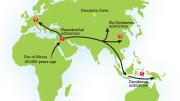To the trained interpreter, the human genome is a record of the human past. Ancient environments leave their imprint through natural selection; meanwhile, patterns of genetic similarity among different individuals hint at aspects of their shared history, ranging from family relationships to mass migrations that happened thousands of years ago.
With the advent of powerful new sequencing technology, genomes past and present are shedding new light on early human history. “Genetics tells you about the movements and relationships of people,” says David Reich, professor of genetics at Harvard Medical School. “These were dark spots, black spots, unknowns for a lot of archaeology.”
The past that has come to light is more complex than researchers had suspected. In 2010, as part of the effort to sequence the Neanderthal genome, Reich and colleagues came to a surprising conclusion: sometime in the distant past, not long after moving out of Africa, modern humans interbred with Neanderthals. In fact, pieces of Neanderthal DNA live on today, in people of European and East Asian heritage.
In a paper published in Nature this January, Reich’s lab identified the lingering traces of this genetic mixture by comparing the genome of a Neanderthal with those of about 1,000 present-day humans. “In each person, you have a personal map that shows where the little bits of Neanderthal ancestry are,” Reich explains. “Each person’s map is quite different…You might have Neanderthal ancestry at your beta-globin gene, and I might not, or vice versa.”
In Europeans and East Asians, these pieces summed to an average of about 2 percent of the genome. But the areas of Neanderthal ancestry were not randomly distributed; in some regions of the genome, in fact, nearly two-thirds of Eurasians showed Neanderthal descent. Natural selection seems to have favored the associated genes, which disproportionately affect skin and hair, and Reich’s team hypothesize that they helped modern humans adapt to their new, non-African environments.
Other details about the interbreeding have surfaced as well. Nothing in the archaeological record so far suggests when or where humans and Neanderthals met, but using genetic evidence, Reich estimates that their last encounters occurred 47,000 to 65,000 years ago. Likewise, he and colleagues found that humans today are most closely related to a Neanderthal individual whose remains were found in the Caucasus Mountains, even though Neanderthals were known to have lived primarily in Europe.
Nevertheless, many aspects of the interbreeding remain in the dark. “We don’t really know how many matings there were,” says Reich. “We don’t know if it was Neanderthal males and modern human females, or the reverse, or equal numbers of both.” Nor is it clear why the interbreeding occurred—whether it was consensual, or influenced by factors like warfare or a need for mates at a time when modern humans were likely outnumbered.
The evidence does show, he says, that “when modern humans and Neanderthals met and mixed, they were already at the edge of biological incompatibility.” The recent study located genomic “deserts” where Neanderthal DNA was rare, suggesting that natural selection may have purged Neanderthal gene variants harmful for humans. On the X chromosome (the sex chromosome that is shared by males and females) in particular, Neanderthal DNA was one-fifth as common as elsewhere—a well-established sign of the barriers to hybridization that develop as two species diverge. Even so, the similarities necessary for genetic mixture to have occurred remained: “Neanderthals and modern humans are closer to each other than might have been thought before,” Reich emphasizes. “They met, they interbred…they produced offspring, and those offspring were raised by one or both parents and contributed to the modern human gene pool.”
More broadly, Reich has found that species boundaries among early hominid groups were by no means fixed boundaries. In 2010, the genome sequencing of an ancient finger bone from a Siberian cave identified an entirely new hominid group, distinct from both humans and Neanderthals, which Reich and collaborators named the Denisovans. The Denisovans, too, once interbred with the forebears of modern humans—Polynesians and Aboriginal Australians show evidence of Denisovan ancestry—and Reich’s team now suspects that Neanderthals interbred with Denisovans as well. More genome sequences, both ancient and modern, are needed to understand all the hypothesized admixtures, but the familiar human evolutionary tree already seems more tangled than previously thought.
Genetic evidence has its limits. It is difficult or impossible, Reich says, to detect migrations of closely related people using genomic techniques. For instance, the powerful techniques that identified pieces of Neanderthal DNA have not been used successfully to detect a genomic signature from the barbarian invasion of Rome, despite its occurring much nearer the present—though Reich thinks that more careful study, combined with additional samples of ancient DNA, may shed light on this and other events in human history. “Genomics tells you something that’s quite complementary to archaeology,” says Reich. “It’s another very rich source of information about the past.”










